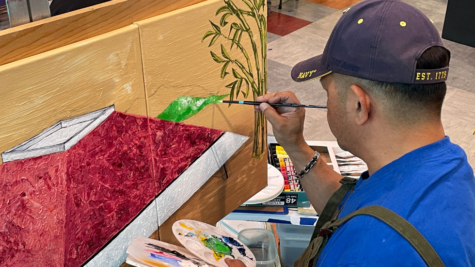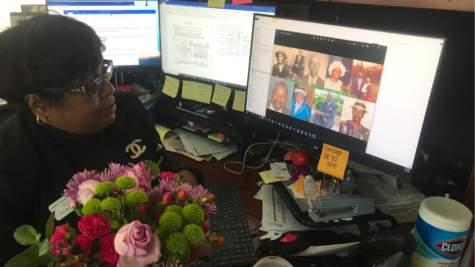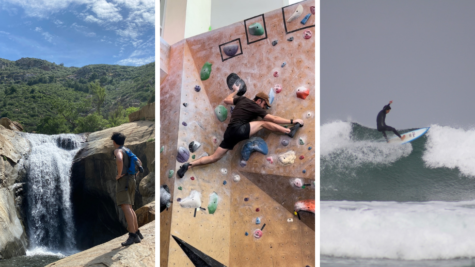City Looks to the Stars
The new science building at San Diego City College, featuring its own planetarium, will open in 2014.Photo credit: Juan Carlos Siezar
Students this spring will have opportunities never dreamed of 100 years ago when City College was founded. Take the new Science Building, located just east of the L building at the corner of 16th and B streets. It has a silvery skin, smallish windows and it looks … techie. There is nothing warm and fuzzy about it, outside or in. It’s about serious science careers that bring real meaning to curious minds, and possibly a substantial income as well.
The structure is ready, and furniture and equipment are arriving daily. Technician Ed Sebring is seeing that everything is installed properly so that students can start off with a splendid experience in the science of their choosing.
The planetarium
The Science Building will have classes in biology, geology, physics, astronomy, chemistry, math and anthropology. One of the more exciting elements for many, will be the planetarium. This new computerized planetarium will allow vast arrays of views of the universe, the planets, our own solar system and the Earth.
What is a planetarium? According to Oxford Dictionaries, a planetarium is, “a building in which images of stars, planets, and constellations are projected on the inner surface of a dome for
public entertainment or education.”
San Diego doesn’t usually offer good opportunities to view the heavens. The splendor of the Milky Way can never be properly observed here. But with the planetarium, you can view it all without having to drive to the mountains or the desert.
Many planetaria around the globe have fixed views provided by numerous lenses that are permanently welded into a fixed position on the projector. The unit installed in City College’s planetarium is the SciDome HD, a two-projector system that can accurately display 1,920-by-1,920 pixels across the dome. It includes a powerful Spitz sound system and computerized controls fit for the Starship Enterprise.
Yes, you can zoom around the Earth using a service such as Google Maps, but here you can do it better and in more satisfying detail. And, until Google maps the universe, this is a great way to see what’s up there without a painful cramp in your neck.
Several of City College’s science staff will bring this all to life for students, including Lisa Will, PhD. — who is also head astronomer for the world renowned Reuben H. Fleet Science Center in Balboa Park; Lisa Chaddock, an enthusiastic lover of earth sciences and more; and Ed Sebring, wizard with chemistry and other science and engineering disciplines.
The Reuben H. Fleet Science Center in Balboa Park — just up the road from City College — was one of the first to offer an OmniMax theater, and an excellent planetarium. Their recently installed projector makes the experience there something to remember.
The Fleet Science Center has geeky thrills for young and old, from video and planetarium presentations to hands-on science displays. You can walk there from City College, but allow some time. It’s next door to the Natural History Museum, and nearby are art museums, botanical displays and the Japanese gardens which currently being expanded. Balboa Park will celebrating its 100th anniversary in 2015, just after City College.
There’s more
City College’s 98,000-square-foot Science Center is loaded with technology. Have you seen the television show, “CSI”? In many ways, City’s facilities are a step ahead.
The facility offers refrigerated tables for budding scientists to explore the bodies. When the work is done, push a button and the body is lowered into the table and refrigerated right there.
Many of the biological and chemical labs are equipped with ventilation systems to draw away any contaminated air for a wholesome breathing experience. Plumbing, electric and data connections allow for enhanced learning and limited distractions.
Staff members have specified equipment and materials to fit their particular teaching requirements and there is much attention to detail. Many lab chairs, for instance, will resist chemical damage while still allowing comfort.
Even with the building’s completion, some students have no idea of what the complex is or that it will be available. Those with an interest in science welcomed the revelation, though. Israel Morando, currently taking physics and planning an engineering degree said, “Cool, I really like the idea.” Another student said that although she will not be in sciences, she thinks it’s great for those who are.
Mysteries
So much lies in the details. Outside the building, for instance, is a sculpture with a big rusty triangle sticking out of the ground. Surrounding it, in a semi-circle is a series of blocks with markings. Go there today and see this for yourself. What is the meaning of this, you may ask? Visit it and solve the puzzle for yourself. While you’re there, also note the water-wise landscaping, the dry rocky riverbed and the large table-like structure with plumbing attachments.
The table will be filled with rocks and sand, and water will flow from one end to the other. Over time, the water will meander. It twists and turns, and refuses to follow a straight path from one end to the other. How and why the water meanders will be a puzzle for students to understand. Look at a map showing rivers and you can see for yourself that they meander. The mighty Mississippi, for example, not only meanders, but it changes from time to time, causing disruption to human activities. Would you be interested in learning why this happens? These displays are designed to raise curiosity and engage learning.
In the past, City College was largely oriented toward training students for blue-collar work or preparation for mainstream universities. The Science Building and many of the new facilities seem to indicate a basic change in direction. Students now will have state-of-the-art science equipment to prepare them for tech and science careers in many fields. No other community college and few major colleges have this level of modern equipment to prepare their students for the future.
What does this mean to you?
“I’m a business major,” some will say, or, “I’m a psychology major,” etc. But ask yourself if you are human. If you are interested in, for example, the environment or energy issues or politics or world peace. This is what separates us from other primates. We are curious, we want to know our origins and we want to know all about the universe around us. If we are human, then we must learn some science. Even if you are a car mechanic or a fast-food worker, you should try to know that there is more to your existence than that. Science is an important part of who you are, where you came from and where you are going.
How can you find an interesting course in the Science Building to enhance your other studies? First of all, visit a counselor; visit the dean of science; visit the Math, Engineering, Scientific Achievement (MESA) center in the L Building; visit one of the science, chemistry or math professors; or talk to a scientist in your family or nearby. Warning — if they get a hint that you might be interested, they’ll talk your ear off.
Your donation will support the student journalists of San Diego City College. Your contribution will allow us to purchase equipment, cover the cost of training and travel to conferences, and fund student scholarships. Credit card donations are not tax deductible. Instead, those donations must be made by check. Please contact adviser Nicole Vargas for more information at nvargas@sdccd.edu.










